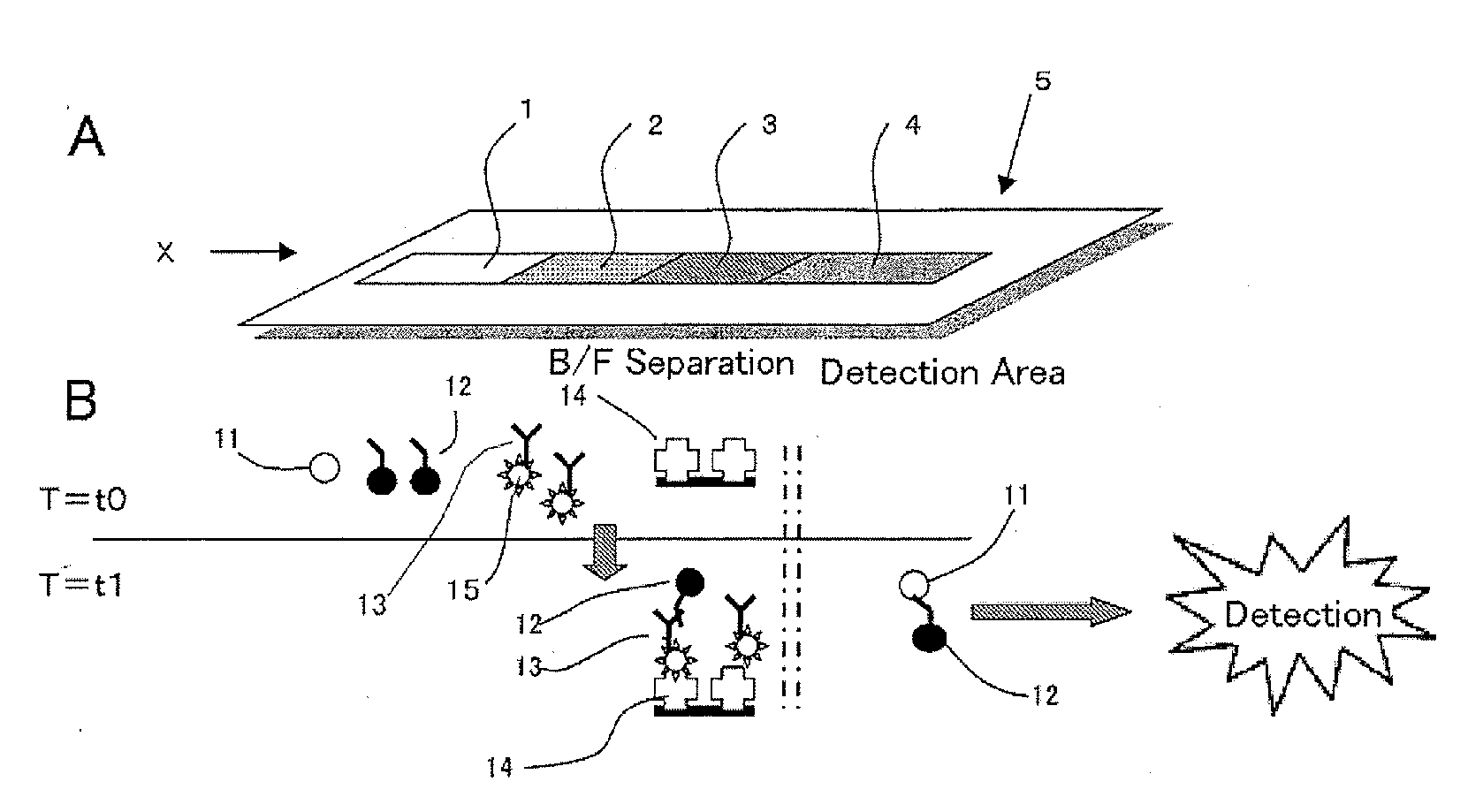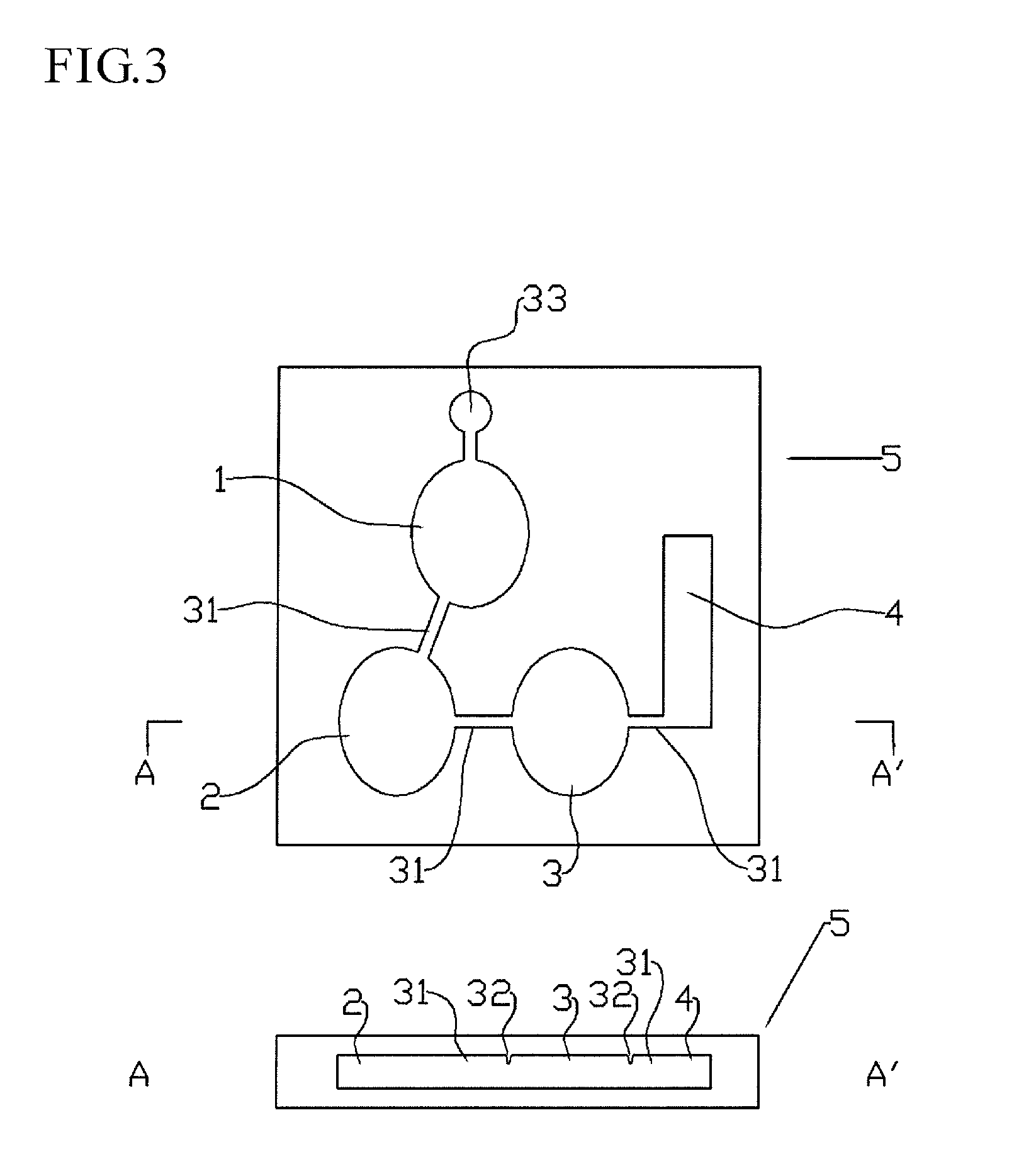Immunoassay device and method
a technology of immunoassay and device, which is applied in the field of immunoassay device, can solve the problems of complex assay operation, lack of quantitative reliability of assay device, and difficulty in concluding that adequate quantitative reliability would be ensured, and achieves simple operation, rapid assay, and high quantitative measurement. high degree of precision
- Summary
- Abstract
- Description
- Claims
- Application Information
AI Technical Summary
Benefits of technology
Problems solved by technology
Method used
Image
Examples
example 1
Preparation of CRP Assay Device in Form of Test Strip
(1 Preparation of Filter Paper for Label Area (First Region)
[0108]10 mg BSA and 10 mg glucose were dissolved in 10 mL PBS buffer. The HRP-labeled anti-human CRP antibody prepared in Example 2 was then diluted 5,000-fold with this solution. Filter paper (by Whatman Japan) was impregnated with the solution and dried, then cut to a size of 12 mm×5 mm.
(2) Preparation of Filter Paper for Biotin Label Antibody (Second Region)
[0109]10 mg BSA and 10 mg sucrose were dissolved in 10 mL PBS buffer. 20 μg / mL solution of the biotin-labeled anti-idiotype antibody prepared in Example 1 was prepared with this solution. Filter paper (by Whatman Japan) was impregnated with the solution and dried, then cut to a size of 10 mm×5 mm.
(3) Preparation of Membrane for Capturing Area (Third Region)
[0110]An avidin 1 mg / mL solution was prepared with PBS. A Hi-Flow membrane (by Millipore) cut to a size of 15 mm×150 mm was impregnated with the solution and drie...
example 2
Preparation of CRP Assay Device in the Form of Biochip
[0114]A biochip was prepared by laminating together first and second substrates having a pattern such that the first, second, third, and fourth regions were disposed in series by means of recesses on one side, with a channel formed between the third and four regions. Metering regions with a capacity of 0.5 to 1.5 μL were provided between each of the first, second, third, and four regions.
[0115]The first region had a space of about 50 mm2 (plane area)×1 mm (depth). 10 μL of the 0.05 mg / mL HRP-labeled anti-human CRP antibody prepared in Example 2 was injected as the first antibody.
[0116]The second region had a space of about 50 mm2 (plane area)×1 mm (depth). 5 uL of the 4.2 mg / mL anti-idiotype antibody was prepared in Example 1 was injected as the second antibody.
[0117]The third region had a space of about 50 mm2 (plane area)×1 mm (depth). 10 uL of avidin-immobilized sepharose gel (gel with 10 mg / mL bound avidin) was introduced the...
example 3
Preparation of CRP Assay Device in the Form of Biochip Using Electrochemical Detection
[0121]As illustrated in FIG. 5, the biochip in this example had the same structure as the biochip in Example 2, except that a pair of carbon black electrodes 25 was formed in the fourth region, and a redox substance was provided. The electrodes were formed with carbon paste to a length of about 10 mm and a thickness of about 15 μm. The electrodes were disposed at a location corresponding to the fourth region on the bottom substrate forming the biochip. When the top substrate was laminated onto the top of the bottom substrate, a part of the electrodes was located inside the biochip, and a part was exposed. In the fourth region, 3 mM ferrocene and 5 mM hydrogen peroxide were also used as a substrate instead of SAT-Blue.
PUM
| Property | Measurement | Unit |
|---|---|---|
| Transport properties | aaaaa | aaaaa |
Abstract
Description
Claims
Application Information
 Login to View More
Login to View More - R&D
- Intellectual Property
- Life Sciences
- Materials
- Tech Scout
- Unparalleled Data Quality
- Higher Quality Content
- 60% Fewer Hallucinations
Browse by: Latest US Patents, China's latest patents, Technical Efficacy Thesaurus, Application Domain, Technology Topic, Popular Technical Reports.
© 2025 PatSnap. All rights reserved.Legal|Privacy policy|Modern Slavery Act Transparency Statement|Sitemap|About US| Contact US: help@patsnap.com



